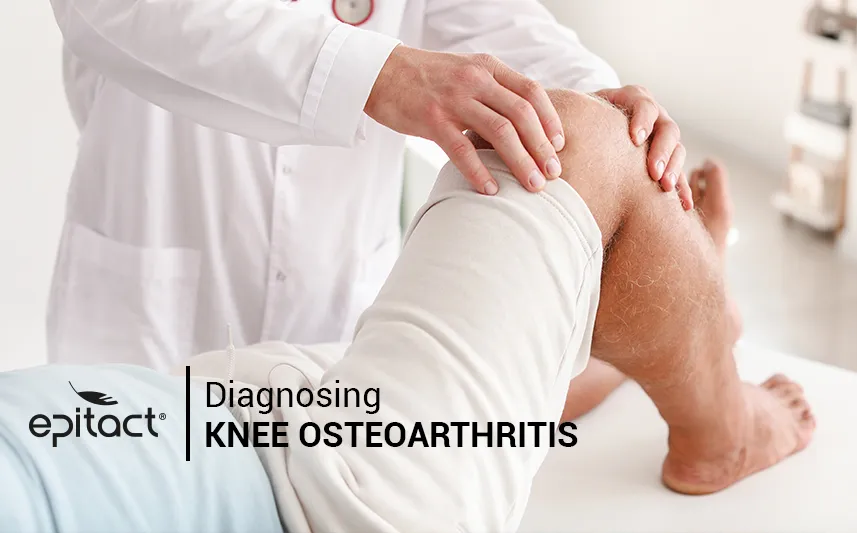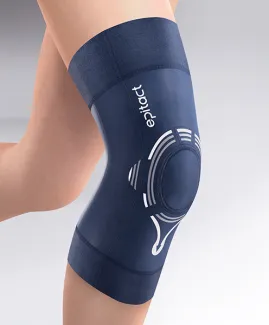
Knee pain is a symptom of many conditions. Your joint cracks, hurts and you’re suspecting knee osteoarthritis (OA), also called knee arthritis? You should consult a healthcare professional who will make the diagnosis of arthritis in the knee.
In this article, learn about the steps in the diagnosis of osteoarthritis in the knee: x-ray, physical exam, medical history taking… and which specialist you should consult.
Which specialist to consult for the diagnosis of arthritis in the knee?
Your knee pain increases and you hesitate about continuing your daily and sport activities. But do you know that osteoarthritis, keeping on doing activities can slow the progression of osteoarthritis in the knee? Consultation with a specialist is essential to determine which behaviour to adopt.
If pain is punctual, your general practitioner will help you find a treatment to relieve symptoms.
If pain appears and intensifies, it is preferable to consult a specialist on your general practitioner’s recommendations. Either a rheumatologist or an orthopaedic surgeon (if the condition is advanced), will be able to confirm or not the diagnosis of osteoarthritis in the knee.

Physical examination for the diagnosis of arthritis in the knee
The best way to diagnose gonarthrosis or knee osteoarthritis is the clinical physical examination. Firstly, your GP the doctor will ask you about the intensity and frequency of your physical activity as well as your symptoms. The latter can be different according to people: redness, swelling, localised or diffuse pain, stiffness, cracking, etc. Symptoms of knee arthritis often change depending on whether you’re in a resting or activity period.
Thanks to physical examination, your practitioner is able to determine if your pain is associated with pressure or movement.
Lastly, this clinical examination is often completed by X-ray images to assess the stage of development of knee osteoarthritis. As a complement to this first examination to diagnose your osteoarthritis in the knee, an X-Ray can be realised to assess the severity of your disease.
Medical imaging to diagnose osteoarthritis in the knee: X-Ray
The knee is a complex joint that includes three parts: the thigh bone (femur), the shin bone (tibia) and the kneecap (patella). In this way, knee osteoarthritis can affect one part of the joint (patellofemoral or tibiofemoral osteoarthritis) or the whole joint, even if it is rarer. To diagnose osteoarthritis in the knee, X-Ray helps to determine which joint is affected. It also helps to find the appropriate medical treatment according to the European League Against Rheumatism (EULAR).
X-Rays for knee arthritis also reveal:
- A potential joint space narrowing due to the cartilage loss and possible cracks in it;
- The presence of osteophytes, also named ‘bone spurs’. Osteophytosis is characterised by bony outgrowths forming on the end of the bone in reaction to cartilage wear and tear;
- A possible condensation of the subchondral bone that supports the joint in the absence of cartilage to protect it;
- Cavities in the bone called subchondral cysts or geodes are symptomatic of osteoarthritis;
- The degree of wear of the subchondral bone in case of advanced osteoarthritis.
Once the diagnosis of knee arthritis is established with certainty, you will be prescribed a specific protocol to stop the process and relieve your joint.
What treatments are available after diagnosis of knee osteoarthritis?
If you’re dealing with patellofemoral osteoarthritis , you could wear a knee brace like the EPITACT® PHYSIOstrap™ MEDICAL* to support your joints and relieve your pain. This light and thin medical device stabilises the kneecap thanks to a silicone tendon and a technical fabric that surrounds the patella without impeding mobility.
During knee flexion, the tendon stretches and comes into tension to counter the potential misalignment of the kneecap from its natural track. Two silicone holding strips (around the thigh and the calf) guarantee that the knee brace stays very well in place and does not slip during the day. This brace is then adapted to people who want to relieve knee joint pain during daily activities.
Your GP can also prescribe medications to reduce pain and inflammation, orthopaedic insoles, lifestyle changes and exercises with a physical therapist.
Now that you know how osteoarthritis in the knee is diagnosed, learn more about the medical and surgical treatments of knee OA.
*PHYSIOstrap™ is a class I medical device that bears the CE marking under this regulation. Carefully read the instructions before use. Manufacturer: Millet Innovation. 09/2021
 Pharmacie
Pharmacie
